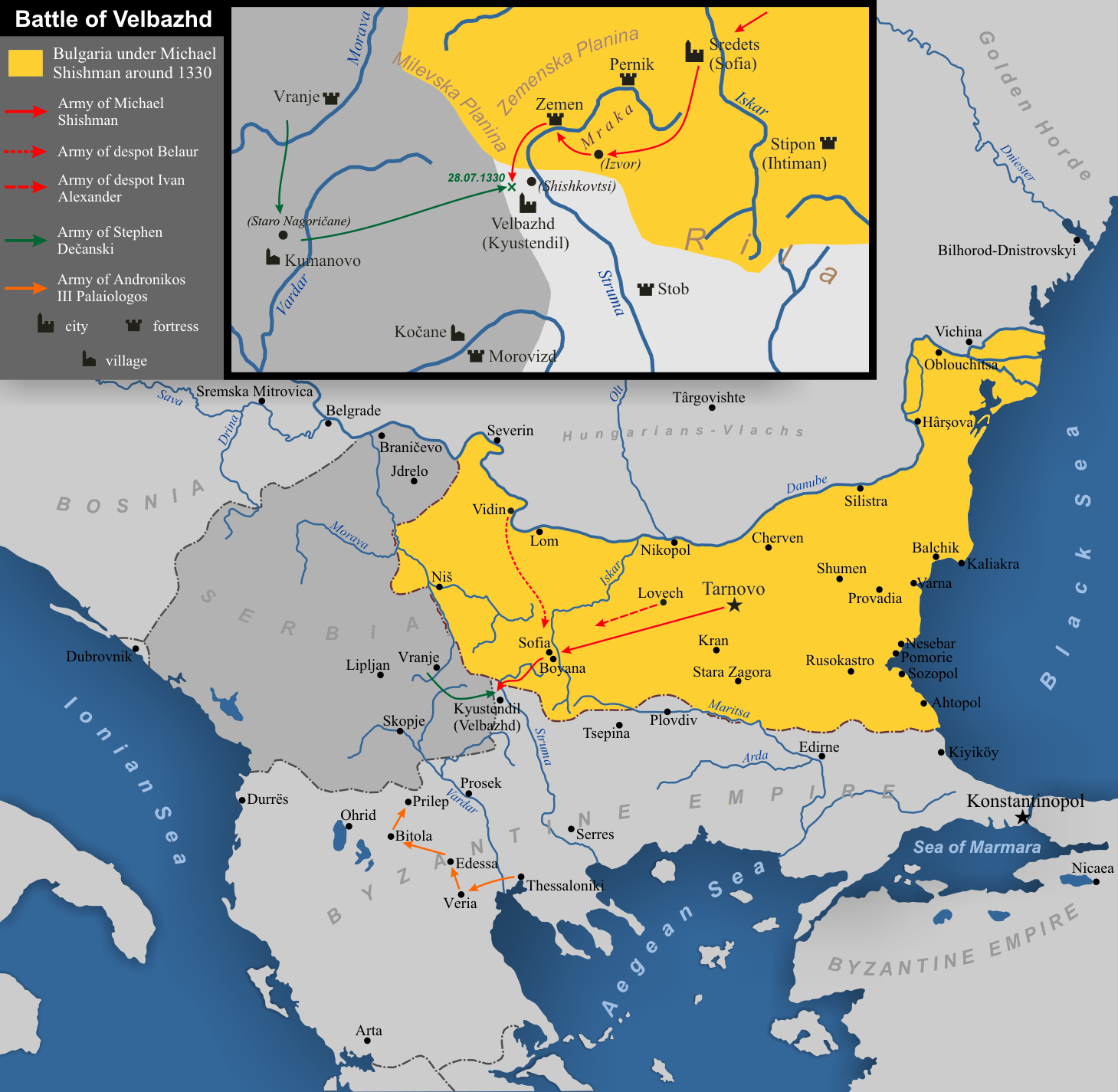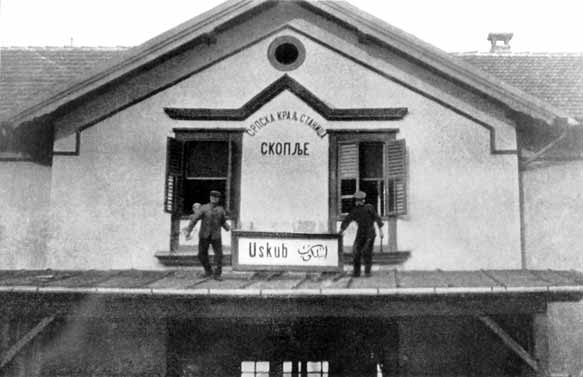|
Battle Of Velbužd
The Battle of Velbazhd (; ) took place between Bulgarian and Serbian armies on 28 July 1330, near the town of Velbazhd (present day Kyustendil). The growing power of the Serbian Kingdom from the late 13th century raised serious concerns in the traditional Balkan powers Bulgaria and Byzantine Empire which agreed for joint military actions against Serbia in 1327. Three years later the bulk of the Bulgarian and Serbian armies clashed at Velbazhd and the Bulgarians were caught by surprise. Serbian victory shaped the balance of power in Balkans for the next two decades. The Bulgarians did not lose territory after the battle but were unable to stop the Serbian advance towards Macedonia. Serbia managed to conquer Macedonia and parts of Thessaly and Epirus reaching its greatest territorial extent ever. Their new king Stefan Dušan was crowned Emperor with support from Bulgarian Patriarch Symeon in 1346. Origins of the conflict During the long but unsuccessful reign of Emperor Consta ... [...More Info...] [...Related Items...] OR: [Wikipedia] [Google] [Baidu] |
Bulgarian–Serbian Wars (medieval)
The Bulgarian–Serbian wars were a series of conflicts between the Bulgarian Empire and medieval Serbian states between the 9th and 14th centuries in the central Balkans. Before the 12th century, the Serbian states were dependent upon and strongly influenced by the dominant Balkan powers, the Bulgarian and Byzantine Empires. The rulers of both those countries sought to control Serb princes to use them as allies in the Byzantine-Bulgarian Wars. The first war between Bulgarians and Serbs occurred during the reign of Presian between 839 and 842, precipitated by Byzantine diplomacy. Later after series of campaigns the Bulgarian Emperor Simeon I conquered and destroyed the Serb state in 924. The Bulgarian Emperor Peter I granted formal independence to Serbia in 931 and appointed his protégé Časlav Klonimirović as its ruler. The most powerful Serbian state of the time, that of Duklja, was again subjugated by Emperor Samuil in 998. In the 13th century Stefan Dragutin and h ... [...More Info...] [...Related Items...] OR: [Wikipedia] [Google] [Baidu] |
Vlachs
Vlach ( ), also Wallachian and many other variants, is a term and exonym used from the Middle Ages until the Modern Era to designate speakers of Eastern Romance languages living in Southeast Europe—south of the Danube (the Balkan peninsula) and north of the Danube. Although it has also been used to name present-day Romanians, the term "Vlach" today refers primarily to speakers of the Eastern Romance languages who live south of the Danube, in Albania, Bulgaria, northern Greece, North Macedonia and eastern Serbia. These people include the ethnic groups of the Aromanians, the Megleno-Romanians and, in Serbia, the Timok Romanians. The term also became a synonym in the Balkans for the social category of shepherds, and was also used for non-Romance-speaking peoples, in recent times in the western Balkans derogatively. The term is also used to refer to the ethnographic group of Moravian Vlachs who speak a Slavic language but originate from Romanians, as well as for Morlachs ... [...More Info...] [...Related Items...] OR: [Wikipedia] [Google] [Baidu] |
Michael Shishman Of Bulgaria
Michael Asen III (), commonly known as Michael Shishman (), ruled as tsar of Bulgaria from 1323 to 1330. The exact year of his birth is unknown but it was between 1280 and 1292. He was the founder of the last ruling dynasty of the Second Bulgarian Empire, the Shishman dynasty. After he was crowned, however, Michael used the name Asen to emphasize his connection with the Asen dynasty, the first one to rule over the Second Empire. An energetic and ambitious ruler, Michael Shishman led an aggressive but opportunistic and inconsistent foreign policy against the Byzantine Empire and the Serbia in the Middle Ages, Kingdom of Serbia, which ended in the disastrous Battle of Velbazhd that claimed his own life. He was the last medieval Bulgarian ruler who aimed at military and political hegemony of the Second Bulgarian Empire, Bulgarian Empire over the Balkans and the last one who attempted to seize Constantinople. He was succeeded by his son Ivan Stephen of Bulgaria, Ivan Stephen and later ... [...More Info...] [...Related Items...] OR: [Wikipedia] [Google] [Baidu] |
Skopje
Skopje ( , ; ; , sq-definite, Shkupi) is the capital and largest city of North Macedonia. It lies in the northern part of the country, in the Skopje Basin, Skopje Valley along the Vardar River, and is the political, economic, and cultural center of the country. As of the 2021 North Macedonia census, 2021 census, the city had a population of 526,502. Skopje covers 571.46 km² and includes both urban and rural areas, bordered by several Municipalities of North Macedonia, municipalities and close to the borders of Kosovo and Serbia. The area of Skopje has been continuously inhabited since at least the Chalcolithic period. The city — known as ''Scupi'' at the time — was founded in the late 1st century during the rule of Domitian, and abandoned in 518 after an earthquake destroyed the city. It was rebuilt under Justinian I. It became a significant settlement under the First Bulgarian Empire, the Serbian Empire (when it served briefly as a capital), and later under the Otto ... [...More Info...] [...Related Items...] OR: [Wikipedia] [Google] [Baidu] |
Constantine Tikh Of Bulgaria
Constantine I Tih () was the tsar of Bulgaria from 1257 to 1277, he was offered the throne from Mitso Asen. He led the Bulgarian Empire at a time when the nearby Byzantine Empire disintegrated into rump states. To strengthen his position, he forged an alliance with one of the rump state—Nicaea—by marrying Irene, a daughter of Theodore II of the prominent Laskaris family. Early in his reign, his army invaded Severin, Hungary which outraged Béla IV; this led Hungarian troops to capture Vidin, an important town of the Bulgarian Empire and also saw the Hungarians besieging the Lower Danube region, leaving northwestern Bulgaria to Rostislav Mikhailovich (Béla's son-in-law), who had claimed Bulgaria in the years prior. When Michael VIII took over the throne of the Byzantine Empire (which led Konstantin to go to war with them in the 1260s) this saw Bulgaria losing significant territories to its two principal enemies, the Byzantines and Hungary. Later, when Tatars began atta ... [...More Info...] [...Related Items...] OR: [Wikipedia] [Google] [Baidu] |
Patriarch Of All Bulgaria
The Patriarch of All Bulgaria () is the patriarch of the Bulgarian Orthodox Church. The patriarch is officially styled as ''Patriarch of All Bulgaria and Metropolitan of Sofia''. The current patriarch Daniil acceded to this position on 30 June 2024. History Medieval era Following two decisive victories over the Byzantines at Achelous (near the present-day city of Burgas) and Katasyrtai (near Constantinople), the autonomous Bulgarian archbishopric was proclaimed autocephalous and elevated to the rank of patriarchate at an ecclesiastical and national council held in 918 or 919. As a result of the Treaty of 927, which affirmed the Bulgarian victory in the Byzantine–Bulgarian war of 913–927, the Patriarchate of Constantinople recognized the autocephalous status of the Bulgarian Orthodox Church and acknowledged its patriarchal dignity. Demetrius of Bulgaria was the second patriarch of the Bulgarian Orthodox Church and the first one to have been recognized by the Ecumenical P ... [...More Info...] [...Related Items...] OR: [Wikipedia] [Google] [Baidu] |
Epirus
Epirus () is a Region#Geographical regions, geographical and historical region, historical region in southeastern Europe, now shared between Greece and Albania. It lies between the Pindus Mountains and the Ionian Sea, stretching from the Bay of Vlorë and the Ceraunian Mountains, Acroceraunian Mountains in the north to the Ambracian Gulf and the ruined Roman Empire, Roman city of Nicopolis in the south.. It is currently divided between the Modern regions of Greece, region of Epirus (region), Epirus in northwestern Greece and the counties of Gjirokastër County, Gjirokastër and Vlorë County, Vlorë in southern Albania. The largest city in Epirus is Ioannina, seat of the Greek region of Epirus, with Gjirokastër the largest city in the Albanian part of Epirus. A rugged and mountainous region, Epirus was the north-west area of ancient Greece. It was inhabited by the Greek tribes of the Chaonians, Molossians, and Thesprotians. It was home to the sanctuary of Dodona, the oldest o ... [...More Info...] [...Related Items...] OR: [Wikipedia] [Google] [Baidu] |
Thessaly
Thessaly ( ; ; ancient Aeolic Greek#Thessalian, Thessalian: , ) is a traditional geographic regions of Greece, geographic and modern administrative regions of Greece, administrative region of Greece, comprising most of the ancient Thessaly, ancient region of the same name. Before the Greek Dark Ages, Thessaly was known as Aeolia (, ), and appears thus in Homer's ''Odyssey''. Thessaly Convention of Constantinople (1881), became part of the modern Greek state in 1881, after four and a half centuries of Ottoman Greece, Ottoman rule. Since 1987 it has formed one of the country's 13 Modern regions of Greece, regions and is further (since the Kallikratis reform of 2011) sub-divided into five regional units of Greece, regional units and 25 municipalities of Greece, municipalities. The capital of the region is Larissa. Thessaly lies in northern central Greece and borders the regions of Macedonia (Greece), Macedonia to the north, Epirus (region), Epirus to the west, Central Greece (geo ... [...More Info...] [...Related Items...] OR: [Wikipedia] [Google] [Baidu] |
Macedonia (region)
Macedonia ( ) is a geographical and historical region of the Balkan Peninsula in Southeast Europe. Its boundaries have changed considerably over time; however, it came to be defined as the modern geographical region by the mid-19th century. Today the region is considered to include parts of six Balkan countries: all of North Macedonia, large parts of Greece and Bulgaria, and smaller parts of Albania, Serbia, and Kosovo. It covers approximately and has a population of around five million. Macedonia (Greece), Greek Macedonia comprises about half of Macedonia's area and population. Its oldest known settlements date back approximately to 7,000 BC. From the middle of the 4th century BC, the Kingdom of Macedon became the dominant power on the Balkan Peninsula; since then Macedonia has had a diverse history. Etymology Both proper nouns ''Makedṓn'' and ''Makednós'' are morphologically derived from the Ancient Greek adjective ''makednós'' meaning "tall, slim", and are related t ... [...More Info...] [...Related Items...] OR: [Wikipedia] [Google] [Baidu] |
Kingdom Of Naples
The Kingdom of Naples (; ; ), officially the Kingdom of Sicily, was a state that ruled the part of the Italian Peninsula south of the Papal States between 1282 and 1816. It was established by the War of the Sicilian Vespers (1282–1302). Until then, the island of Sicily and southern Italy had constituted the "Kingdom of Sicily". When the island of Sicily revolted and was conquered by the Crown of Aragon, it become a separate kingdom also called the Kingdom of Sicily. This left the Neapolitan mainland in the possession of Charles of Anjou who continued to use the name "Kingdom of Sicily". Later, two competing lines of the Angevin family competed for the Kingdom of Naples in the late 14th century, which resulted in the murder of Joanna I at the hands of her successor, Charles III of Naples. Charles' daughter Joanna II adopted King Alfonso V of Aragon as heir, who would then unite Naples into his Aragonese dominions in 1442. As part of the Italian Wars, France briefly r ... [...More Info...] [...Related Items...] OR: [Wikipedia] [Google] [Baidu] |








